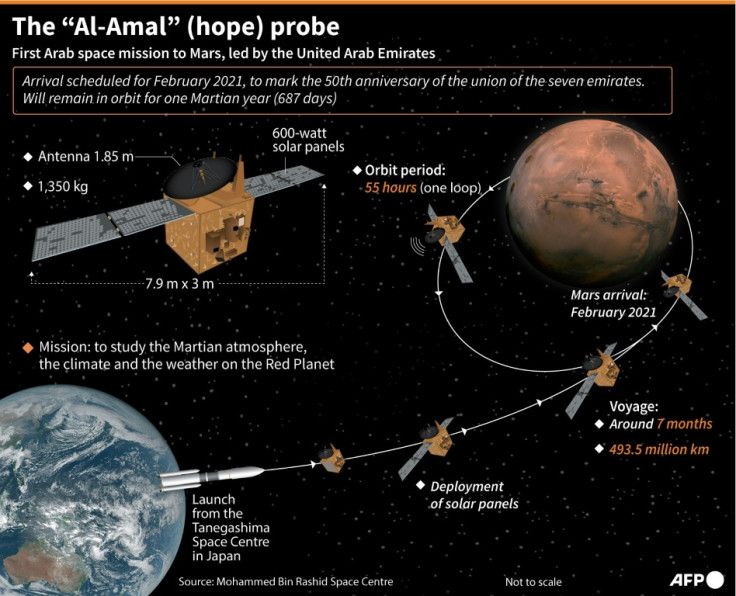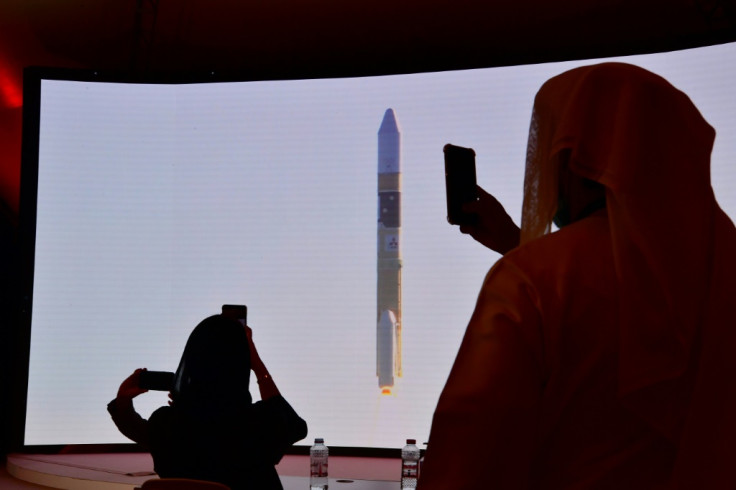Emirati 'Hope' probe heads for Mars
The Al-Amal or Hope probe, officials say is designed to inspire the region's youth and pave the way for scientific breakthroughs.
The first Arab space mission to Mars blasted off from Japan on Monday on a mission to unravel the secrets of weather on the Red Planet.
The unmanned probe named Al-Amal -- Arabic for Hope -- took off after several weather delays, marking the next step in the United Arab Emirates' ambitious space programme.
Here are some facts and figures about the oil-rich nation's project, which draws inspiration from the Middle East's golden age of cultural and scientific achievements.

The UAE, made up of seven emirates including the capital Abu Dhabi and freewheeling Dubai, has nine functioning satellites in orbit with plans to launch another eight in coming years.
In September, it sent the first Emirati into space -- Hazza al-Mansouri, who was part of a three-member crew. They blasted off on a Soyuz rocket from Kazakhstan, returning home after an eight-day mission in which he became the first Arab to visit the International Space Station.
But the UAE's ambitions go well beyond that, with a goal of building a human settlement on Mars by 2117.

In the meantime, it plans to create a white-domed "Science City" in the deserts outside Dubai, to simulate Martian conditions and develop the technology needed to colonise the planet.
Under a national space strategy launched last year, the UAE is also eyeing future mining projects beyond Earth and space tourism, and has signed a memorandum of understanding with Richard Branson's space tourism company Virgin Galactic.
The next milestone was the launch of the "Hope" probe, which officials say is designed to inspire the region's youth and pave the way for scientific breakthroughs.

The 1,350-kilogramme (2,970-pound) probe -- about the size of an SUV -- lifted off from Japan's Tanegashima Space Center on Monday at 6:58 am local time (2158 GMT Sunday) after poor weather delayed initial plans.
The probe successfully detached from the Japanese launch rocket about an hour after blast-off, with a UAE space official hailing the launch as an "important milestone for the UAE and the region."
Unlike the other two Mars ventures scheduled for this year, including Tianwen-1 from China and Mars 2020 from the United States, the UAE's probe will not land on the Red Planet but orbit it for a whole Martian year -- 687 days.
Hope will take seven months to travel the 493 million kilometres (307 million miles) to Mars, in time to mark the 50th anniversary of the emirates' union in 2021.
Once in orbit, one loop will take 55 hours at an average speed of 121,000 kph, while contact with the UAE command and control centre will be limited to six to eight hours twice a week.
Three instruments mounted on the probe will provide a picture of the Mars atmosphere throughout the Martian year.
The first is an infrared spectrometer to measure the lower atmosphere and analyse the temperature structure.
The second is a high-resolution imager that will provide information about ozone levels. And the third, an ultraviolet spectrometer, is set to measure oxygen and hydrogen levels from a distance of up to 43,000 kilometres from the surface.
Understanding the atmospheres of other planets will allow for a better understanding of the Earth's climate, officials say.
But the project is also designed to inspire a region too often beset by turmoil, and recall its heyday of scientific advances during the Middle Ages.
"The UAE wanted to send a strong message to the Arab youth and to remind them of the past, that we used to be generators of knowledge," Omran Sharaf, the mission's project manager, told AFP.
Copyright AFP. All rights reserved.
This article is copyrighted by International Business Times, the business news leader





















